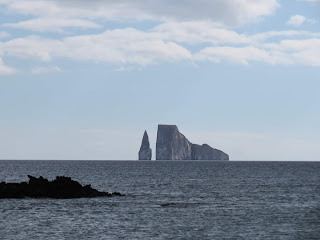After the rigorous trek in the morning, we were all happy to hear we would get some time to just explore the beach on another part of San Cristobal island.
The highlight was watching the blue-footed boobies dive into the ocean for fish. I tried and tried to get a decent video with no luck. They dive head first really fast and stun the fish on impact. Then swim back up and pick them off the surface.
Kicker's rock in the distance - a landmark cited by Darwin when he visited the islands.
And, of course, a sea lion welcome committee.
Remember the Sally Lightfoot crabs from an earlier post? Here's one of the juveniles - can you spot it?
This is actually a pelican, not a blue-footed booby diving, but still a cool shot.
And this was our first glimpse of a marine iguana - they can hold their breath under water for up to an hour - how do we know? Darwin tied a rock to one, then forgot about him, pulled him up an hour later and it was still alive. They eat seaweed and 'sneeze' away all the salt. That crust on his head is salt so thick it won't even wash off.
Back on the boat in time to view a lovely sunset.
The highlight was watching the blue-footed boobies dive into the ocean for fish. I tried and tried to get a decent video with no luck. They dive head first really fast and stun the fish on impact. Then swim back up and pick them off the surface.
Kicker's rock in the distance - a landmark cited by Darwin when he visited the islands.
And, of course, a sea lion welcome committee.
Remember the Sally Lightfoot crabs from an earlier post? Here's one of the juveniles - can you spot it?
This is actually a pelican, not a blue-footed booby diving, but still a cool shot.
And this was our first glimpse of a marine iguana - they can hold their breath under water for up to an hour - how do we know? Darwin tied a rock to one, then forgot about him, pulled him up an hour later and it was still alive. They eat seaweed and 'sneeze' away all the salt. That crust on his head is salt so thick it won't even wash off.
Back on the boat in time to view a lovely sunset.













































